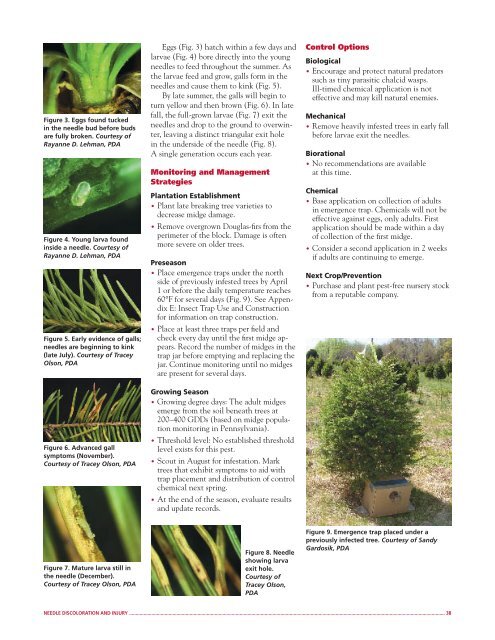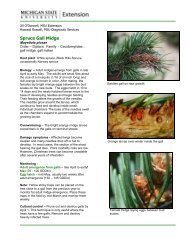Integrated Pest Management for Christmas Tree Production: A ...
Integrated Pest Management for Christmas Tree Production: A ...
Integrated Pest Management for Christmas Tree Production: A ...
You also want an ePaper? Increase the reach of your titles
YUMPU automatically turns print PDFs into web optimized ePapers that Google loves.
Figure 3. Eggs found tucked<br />
in the needle bud be<strong>for</strong>e buds<br />
are fully broken. Courtesy of<br />
Rayanne D. Lehman, PDA<br />
Figure 4. Young larva found<br />
inside a needle. Courtesy of<br />
Rayanne D. Lehman, PDA<br />
Figure 5. Early evidence of galls;<br />
needles are beginning to kink<br />
(late July). Courtesy of Tracey<br />
Olson, PDA<br />
Figure 6. Advanced gall<br />
symptoms (November).<br />
Courtesy of Tracey Olson, PDA<br />
Figure 7. Mature larva still in<br />
the needle (December).<br />
Courtesy of Tracey Olson, PDA<br />
Eggs (Fig. 3) hatch within a few days and<br />
larvae (Fig. 4) bore directly into the young<br />
needles to feed throughout the summer. As<br />
the larvae feed and grow, galls <strong>for</strong>m in the<br />
needles and cause them to kink (Fig. 5).<br />
By late summer, the galls will begin to<br />
turn yellow and then brown (Fig. 6). In late<br />
fall, the full-grown larvae (Fig. 7) exit the<br />
needles and drop to the ground to overwinter,<br />
leaving a distinct triangular exit hole<br />
in the underside of the needle (Fig. 8).<br />
A single generation occurs each year.<br />
Monitoring and <strong>Management</strong><br />
Strategies<br />
Plantation Establishment<br />
• Plant late breaking tree varieties to<br />
decrease midge damage.<br />
• Remove overgrown Douglas-fi rs from the<br />
perimeter of the block. Damage is often<br />
more severe on older trees.<br />
Preseason<br />
• Place emergence traps under the north<br />
side of previously infested trees by April<br />
1 or be<strong>for</strong>e the daily temperature reaches<br />
60°F <strong>for</strong> several days (Fig. 9). See Appendix<br />
E: Insect Trap Use and Construction<br />
<strong>for</strong> in<strong>for</strong>mation on trap construction.<br />
• Place at least three traps per fi eld and<br />
check every day until the fi rst midge appears.<br />
Record the number of midges in the<br />
trap jar be<strong>for</strong>e emptying and replacing the<br />
jar. Continue monitoring until no midges<br />
are present <strong>for</strong> several days.<br />
Growing Season<br />
• Growing degree days: The adult midges<br />
emerge from the soil beneath trees at<br />
200–400 GDDs (based on midge population<br />
monitoring in Pennsylvania).<br />
• Threshold level: No established threshold<br />
level exists <strong>for</strong> this pest.<br />
• Scout in August <strong>for</strong> infestation. Mark<br />
trees that exhibit symptoms to aid with<br />
trap placement and distribution of control<br />
chemical next spring.<br />
• At the end of the season, evaluate results<br />
and update records.<br />
Figure 8. Needle<br />
showing larva<br />
exit hole.<br />
Courtesy of<br />
Tracey Olson,<br />
PDA<br />
Control Options<br />
Biological<br />
• Encourage and protect natural predators<br />
such as tiny parasitic chalcid wasps.<br />
Ill-timed chemical application is not<br />
effective and may kill natural enemies.<br />
Mechanical<br />
• Remove heavily infested trees in early fall<br />
be<strong>for</strong>e larvae exit the needles.<br />
Biorational<br />
• No recommendations are available<br />
at this time.<br />
Chemical<br />
• Base application on collection of adults<br />
in emergence trap. Chemicals will not be<br />
effective against eggs, only adults. First<br />
application should be made within a day<br />
of collection of the fi rst midge.<br />
• Consider a second application in 2 weeks<br />
if adults are continuing to emerge.<br />
Next Crop/Prevention<br />
• Purchase and plant pest-free nursery stock<br />
from a reputable company.<br />
Figure 9. Emergence trap placed under a<br />
previously infected tree. Courtesy of Sandy<br />
Gardosik, PDA<br />
NEEDLE DISCOLORATION AND INJURY ................................................................................................................................................................................................................................................ 38





